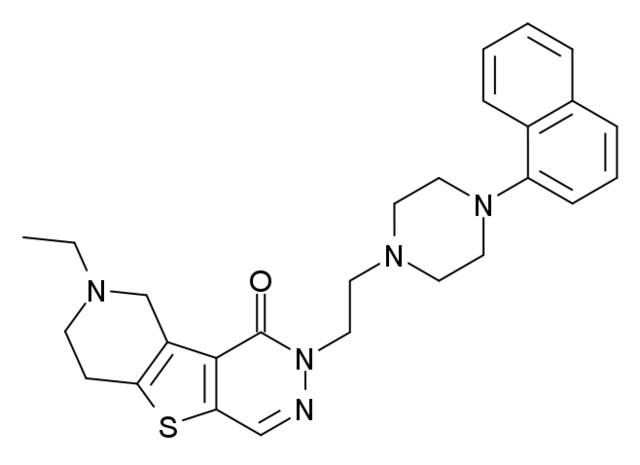5-Hydroxytryptamine (serotonin) receptor 5A, also known as HTR5A, is a protein that in humans is encoded by the HTR5A gene.[5][6] Agonists and antagonists for 5-HT receptors, as well as serotonin uptake inhibitors, present promnesic (memory-promoting) and/or anti-amnesic effects under different conditions, and 5-HT receptors are also associated with neural changes.
Quick Facts HTR5A, Identifiers ...
Close
The gene described in this record is a member of 5-hydroxytryptamine receptor family and encodes a multi-pass membrane protein that functions as a receptor for 5-hydroxytryptamine and couples to G proteins, negatively influencing cAMP levels via Gi and Go.[7] This protein has been shown to function in part through the regulation of intracellular Ca2+ mobilization.[5] The 5-HT5A receptor has been shown to be functional in a native expression system.[8]
Rodents have been shown to possess two functional 5-HT5 receptor subtypes, 5-HT5A and 5-HT5B,[9] however while humans possess a gene coding for the 5-HT5B subtype, its coding sequence is interrupted by stop codons, making the gene non-functional, and so only the 5-HT5A subtype is expressed in human brain.[10]
It also appears to serve as a presynaptic serotonin autoreceptor.[11]
The neurotransmitter serotonin (5-hydroxytryptamine, 5-HT) has been implicated in a wide range of psychiatric conditions and also has vasoconstrictive and vasodilatory effects.[5]
Few highly selective ligands are commercially available for the 5-HT5A receptor. When selective activation of this receptor is desired in scientific research, the non-selective serotonin receptor agonist 5-Carboxamidotryptamine can be used in conjunction with selective antagonists for its other targets (principally 5-HT1A, 5-HT1B, 5-HT1D, and 5-HT7). Research in this area is ongoing.[12][13]
Agonists

Francken BJ, Jurzak M, Vanhauwe JF, Luyten WH, Leysen JE (November 1998). "The human 5-ht5A receptor couples to Gi/Go proteins and inhibits adenylate cyclase in HEK 293 cells". European Journal of Pharmacology. 361 (2–3): 299–309. doi:10.1016/S0014-2999(98)00744-4. PMID 9865521. Thomas DR, Soffin EM, Roberts C, Kew JN, de la Flor RM, Dawson LA, et al. (September 2006). "SB-699551-A (3-cyclopentyl-N-[2-(dimethylamino)ethyl]-N-[(4'-{[(2-phenylethyl)amino]methyl}-4-biphenylyl)methyl]propanamide dihydrochloride), a novel 5-ht5A receptor-selective antagonist, enhances 5-HT neuronal function: Evidence for an autoreceptor role for the 5-ht5A receptor in guinea pig brain". Neuropharmacology. 51 (3): 566–577. doi:10.1016/j.neuropharm.2006.04.019. PMID 16846620. S2CID 543423. Peters JU, Lübbers T, Alanine A, Kolczewski S, Blasco F, Steward L (January 2008). "Cyclic guanidines as dual 5-HT5A/5-HT7 receptor ligands: optimising brain penetration". Bioorganic & Medicinal Chemistry Letters. 18 (1): 262–266. doi:10.1016/j.bmcl.2007.10.078. PMID 18023344. The RBI Handbook of Receptor Classification and Signal Transduction, page 114 (1995)ISBN 0-9640548-1-7 Roth BL, Driscol J. "PDSP Ki Database". Psychoactive Drug Screening Program (PDSP). University of North Carolina at Chapel Hill and the United States National Institute of Mental Health. Retrieved 14 August 2017. US 6750221, Garcia-Ladona FJ, Szabo L, Steiner G, Hofmann HP, "Use of 5-HT5-ligands in the treatment of neurodegenerative and neuropsychiatric disturbances", published 2004-06-15
- Raymond JR, Mukhin YV, Gelasco A, Turner J, Collinsworth G, Gettys TW, et al. (2002). "Multiplicity of mechanisms of serotonin receptor signal transduction". Pharmacology & Therapeutics. 92 (2–3): 179–212. doi:10.1016/S0163-7258(01)00169-3. PMID 11916537.
- Thomas DR (September 2006). "5-ht5A receptors as a therapeutic target". Pharmacology & Therapeutics. 111 (3): 707–714. doi:10.1016/j.pharmthera.2005.12.006. PMID 16516972.
- Rees S, den Daas I, Foord S, Goodson S, Bull D, Kilpatrick G, Lee M (December 1994). "Cloning and characterisation of the human 5-HT5A serotonin receptor". FEBS Letters. 355 (3): 242–246. doi:10.1016/0014-5793(94)01209-1. PMID 7988681. S2CID 36425845.
- Schanen NC, Scherer SW, Tsui LC, Francke U (1997). "Assignment of the 5-hydroxytryptamine (serotonin) receptor 5A gene (HTR5A) to human chromosome band 7q36.1". Cytogenetics and Cell Genetics. 72 (2–3): 187–188. doi:10.1159/000134184. hdl:10722/42533. PMID 8978771.
- The Sanger Centre; The Washington University Genome Sequencing Cente (November 1998). "Toward a complete human genome sequence". Genome Research. 8 (11): 1097–1108. doi:10.1101/gr.8.11.1097. PMID 9847074.
- Francken BJ, Josson K, Lijnen P, Jurzak M, Luyten WH, Leysen JE (May 2000). "Human 5-hydroxytryptamine(5A) receptors activate coexpressed G(i) and G(o) proteins in Spodoptera frugiperda 9 cells". Molecular Pharmacology. 57 (5): 1034–1044. PMID 10779389.
- Marazziti D, Ori M, Nardini M, Rossi A, Nardi I, Cassano GB (2001). "mRNA expression of serotonin receptors of type 2C and 5A in human resting lymphocytes". Neuropsychobiology. 43 (3): 123–126. doi:10.1159/000054878. PMID 11287788. S2CID 20724896.
- Iwata N, Ozaki N, Inada T, Goldman D (March 2001). "Association of a 5-HT(5A) receptor polymorphism, Pro15Ser, to schizophrenia". Molecular Psychiatry. 6 (2): 217–219. doi:10.1038/sj.mp.4000829. PMID 11317225.
- Grailhe R, Grabtree GW, Hen R (April 2001). "Human 5-HT(5) receptors: the 5-HT(5A) receptor is functional but the 5-HT(5B) receptor was lost during mammalian evolution". European Journal of Pharmacology. 418 (3): 157–167. doi:10.1016/S0014-2999(01)00933-5. PMID 11343685.
- Noda M, Yasuda S, Okada M, Higashida H, Shimada A, Iwata N, et al. (January 2003). "Recombinant human serotonin 5A receptors stably expressed in C6 glioma cells couple to multiple signal transduction pathways". Journal of Neurochemistry. 84 (2): 222–232. doi:10.1046/j.1471-4159.2003.01518.x. PMID 12558985. S2CID 7364018.
- Khorana N, Smith C, Herrick-Davis K, Purohit A, Teitler M, Grella B, et al. (August 2003). "Binding of tetrahydrocarboline derivatives at human 5-HT5A receptors". Journal of Medicinal Chemistry. 46 (18): 3930–3937. doi:10.1021/jm030080s. PMID 12930153.
- Dietz BM, Mahady GB, Pauli GF, Farnsworth NR (August 2005). "Valerian extract and valerenic acid are partial agonists of the 5-HT5a receptor in vitro". Brain Research. Molecular Brain Research. 138 (2): 191–197. doi:10.1016/j.molbrainres.2005.04.009. PMC 5805132. PMID 15921820.
- "5-ht5a". IUPHAR Database of Receptors and Ion Channels. International Union of Basic and Clinical Pharmacology.
- Human HTR5A genome location and HTR5A gene details page in the UCSC Genome Browser.
This article incorporates text from the United States National Library of Medicine, which is in the public domain.